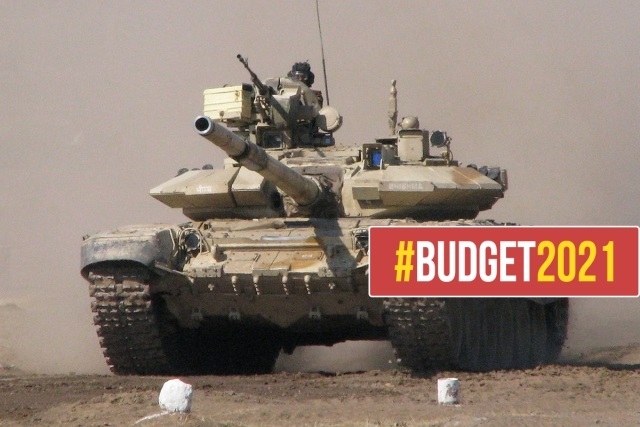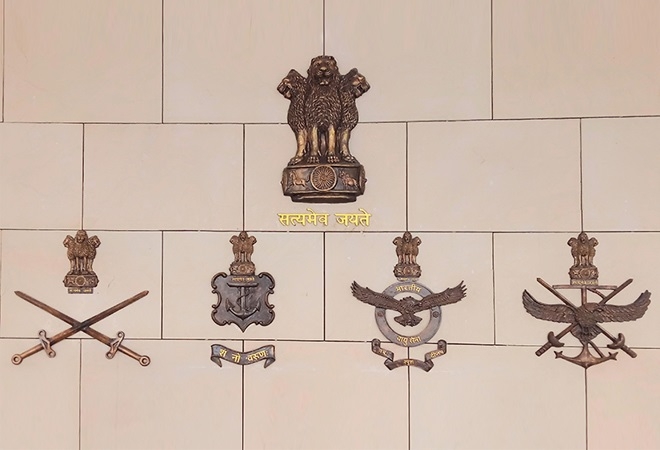Defence sector after 110 minutes of Budget 2021-22!
Total Views |
When it came to power in 2014, Modi Government had said that National Security is its Top Most Agenda. Since then, it has taken several steps to modernise Armed Forces by increasing Defence Spending. 2020 was an exceptional year wherein, our Armed Forces have locked horns with China directly, while at the same time, Pakistan waited in the shadows. Union Budget was presented in Parliament on 01 February,2021 by Finance Minister Ms Nirmala Sitaraman under this strain. She emphasized on Six Pillars for Development viz Health and well being, Physical and Financial Capital and Infra, Inclusive Development, Reinvigorating Human Capital, Innovations in Research and Development and Minimum government and maximum governance, in this Fiscal Year.
Contrary to all expectations, she did not utter a single word about Monetary Allotment to Defence Ministry in her speech spanning 110 minutes. In a way, it is always good to keep others guessing as to what the Government is planning/doing for Defence to retrieve the situation on Northern Borders. In International Arena, cloak of secrecy is better than showing your cards. In her speech, she did make mention of contribution of Armed Forces in War for Liberation of Bangla Desh in 1971 along with two remotely Defence related issues. First was establishment of 100 Sainik Schools and second was provisions to launch an Unmanned Space Vehicle (Gaganyaan) in Space.

Sainik School helps create a suitable base for entry in to National Defence Academy. Presently there are 36 Sainik Schools in India and judicious placement of additional 100 will have minimum three such schools per State/Union Territory. Launch of an Unmanned Space Vehicle in the Space would enhance capabilities of our Space Force in fighting Satellite Warfare of future. Out of Five Pillars mentioned above, Incentive for Infrastructural Development including building of Roads and Infra in the hinder land, Innovations in Research and Development, Enhancement of Make in India, Tax incentives provided to SMES and Provision of guaranty to FDI also relate to Defence in its own way.
Over decades, successive Finance Ministers have routinely promised that there will be no shortage of funds for Armed Forces, and all additional monies which they may require will be provided. Defence Minister Ms Nirmala Sitharaman had declared in July 2019 that there was neither a shortage of funds nor of ammunition in direct contrast to findings of Defence Parliamentary Standing Committee on Defence that had publicly affirmed a shortage of funds for the military. She proved to be true to her words as she gave powers for emergency purchases to Services Chiefs and Vice Chiefs. Present Government, when assumed charge in 2014, had allotted Rs 2.29 lac crore to Defence. It has been increasing steadily and for 2021-22, Defence Allotment stands at Rs 4.78 lac crore. She has almost doubled the amount during her regime.
Allotment of Rs 4.78 lac crore includes Rs 1,15 lac for Pension. So, actual allotment is Rs 3.63 lac crore. This accounts for expenditure of Rs 1.35 lac under Capital Head for purchase of new military hardware and Rs 2.28 lac crore under Revenue Head towards salary, daily maintenance and emergency purchases. Present Defence Allotment of Rs 4,78,195 point 62 crore is more by Rs 6,817 point 62 crore than what was allotted in 2020-21.Rs 1,35,060 has been allotted for modernisation of Armed Forces under Capital Head which is more by Rs 3,326 crore than last year. In all other countries of the world except India, allotment under Capital Head is always more than Revenue Head. Though Defence Minister has praised this allotment, it has demoralized Defence who were expecting a substantial increase in allotment.
Key expectation from this Budget was an increased Capital Budgetary Allocation to fast track some of the big ticket programmes such as Naval Utility Helicopters, Light Combat Aircraft, Futuristic Infantry Combat Vehicle, Anti Tank Guided Missiles,AK47/60 Rifles and P-75I Submarines. There is always a mismatch between the financial requirement projected by the Armed Forces and actual outlays allocated to them as is evident from the gap of Rs 23,014 crore in 2010-11 to Rs 1,03,535 crore in 2020-22. Looking at the double threat from China and Pakistan at the Line of Actual Control and Line of Control since 06 May, 2020, it was imperative that we invest in building Long Term Indigenous Capabilities for application across the board by acquiring Niche Technologies, including Artificial Intelligence, Autonomous Unmanned Systems, Long range Precision Technology, Quantum Computing, Swarm Drones as part of our deliberate and continuous process. This conflict warranted to hike Defence Budget substantially for the financial year 2021-22 to six and a half lac crore.
Reason for this increased demand is the stark fact that Armed Forces are up against China, a country with the second largest Defence Budget in the world. In 2020-21, China’s official defence budget stood at $175 billion, three times that of India. Major components of Chinese military activities are not reflected in the defence budget figures released by their government; a fact which has been substantiated by Stockholm International Peace Research Institute who pegged China’s actual defence budget in 2019 at $240 billion as compared to the official figure of $175 billion. Proposed meager allotment to Indian Defence will/is bond to raise questions like; would buying more tanks make sense when the enemy has Anti Tank Guided Missiles and Attack Helicopters, would investing in latest Air Defence Systems or importing more single engine fighters when India has its own make sense, does Navy need more Submarines or a Third Aircraft Carrier, would Unmanned Armed Drones give effective dog fights with Fighter Aircraft? Recent war between Azerbaijan and Armenia which demonstrated how modern technology can really pulverise Traditional Defence Systems would support these doubts.
To offset such questions, we must have a Coherent Forward Looking Policy on Defence Procurement and Modernisation. Government must put greater emphasis, on research not only in Defence Research and Development Organisation but also in Private Sector and push ahead forcefully with integration of the Three Services. Reason for this became obvious when Army and Air Force had a Tift over control of Apache Helicopters, resulting in separate purchase orders costing the defence budget at least Rs 2,500 crore extra. Ministry of Defence has updated Defence Acquisition Policy in 2020 but its ultimate objective of self reliance would be achieved only if a meaningful fund allocation coupled with tax incentives for achieving the key expectation is provided to the concerned people. This seems to have been achieved in current Budget. Currently, Indian Defence Industry is facing challenges in establishing a broad base of local manufacturing due to Lack of Economies of Scale, Transfer of Technology and Research and Development issues. Tax rebate for Research and Development would provide access to modern technology on the back of strong start-up base.

Government, in 2020-21, had announced an embargo on the import of 101 Defence Items, including armoured vehicles, assault rifles, missiles,to make India 'Self Reliant' in Defence Sector as it has become a Strategic Necessity. This deficiency is now to be made up by focusing on procuring 'Make in India' products for the Armed Forces in the upcoming financial year. To facilitate that, Government had raised Foreign Direct Investment Limit in the Defence Sector from 49 per cent to 74 per cent under the automatic route. This has been reiterated by Defence Minister while inaugurating Aero Space Exhibition at Bengluru on 02 February,2021.
Government had also laid out an ambitious target in Revised Defence Production and Export Promotion Policy to double the domestic procurement from the current Rs 70,000 crore to Rs 1, 40,000 crore by 2025. Resultantly, future Key Procurements are likely to be concluded with Indian Vendors manufacturing domestically hereafter. In this context, synergies between Defence Market and Civil Aviation is an eye opener. Realigning policy framework for Defence and Civil Aviation Sector will help in garnering investments in the Aviation Sector promoting co development and strengthening Defence Ecosystem while leveraging economies of scale. Finance Minister has set her eyes on such synergies in various fields, including Defence, in current budget
Indian Defennce faces a massive financial predicament in the fiscal year 2021-22, as it remains locked in a costly faceoff with China’s People’s Liberation Army along the Line of Actual Control (LAC) in eastern Ladakh. To meet this forbidding challenge that shows no sign of abating, all Three Services are believed to have already executed emergency purchases of over $2 billion since June 2020 to plug enduring equipment and ammunition shortages, adversely upsetting budgetary calculations. Indian Defence Planners must realize that creating industrial facilities domestically to manufacture these platforms and equipment needs massive and sustained investment by the manufacturers and large budget outlays to buy the indigenously manufactured material.
In this context it is noteworthy that, orders for 83 Light Combat Aircraft Mk1A have been given to Hindustan Aeronautics Limited, Tenders have been floated for 114 Multi Role Fighter Aircrafts, Light Combat Aircraft Mk2 is in the Design & Development phase at HAL, Naval Helicopter purchase is in pipe line, Future Infantry Combat Vehicle are being scouted for. These are some of the large schemes for Defence which are being progressed through Make in India Route. Since Troops are deployed in the Galwan Valley of Eastern Ladakh, these things are required on an “Urgent Basis”. Chief of Defence Staff has been supervising a Five Year Safeguard Modernization Plan and a Two Year Annual Roll On Plan under Integrated Capability Development Plan to make arrangements to counter the enemy by enhancing capacity of Army/Navy/Air Force.
He is additionally planning New Theater Commands and the focus is on Integration of the Services, Prioritization and Financing. Therefore, Ministry of Defence would have to keep these new changes in mind too. In view of the ongoing tension along the border, there is a requirement of managing Defence Budget for the situation of War on Two Fronts by creating Defense Modernization Fund which gets carried out to next year in case it is not spent without getting lapsed. Reason being, military procurement and construction of infrastructure facilities such as roads and bridges goes on for a long time, so it is not possible to spend the budget in a year.
Defence Budget, though has not given any substantial economic fill up to Armed Forces, there is lot to read between the lines. Finance Minister has laid her cards open. It has revealed many and concealed few. May be by default, may be intentionally. It is up to the individual observer to interpret it as per his liking and convenience.
.
.
